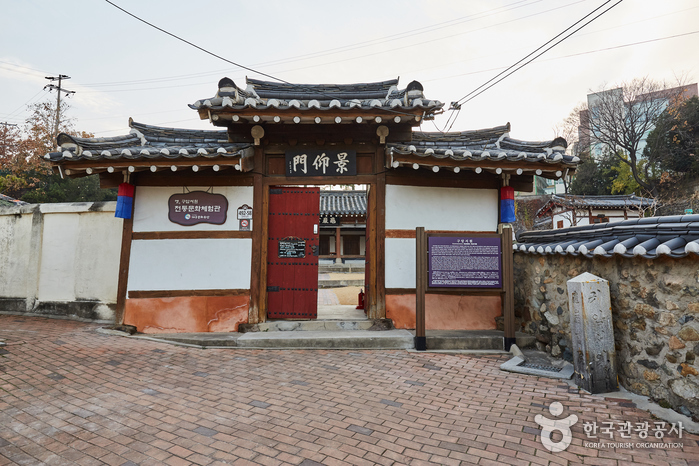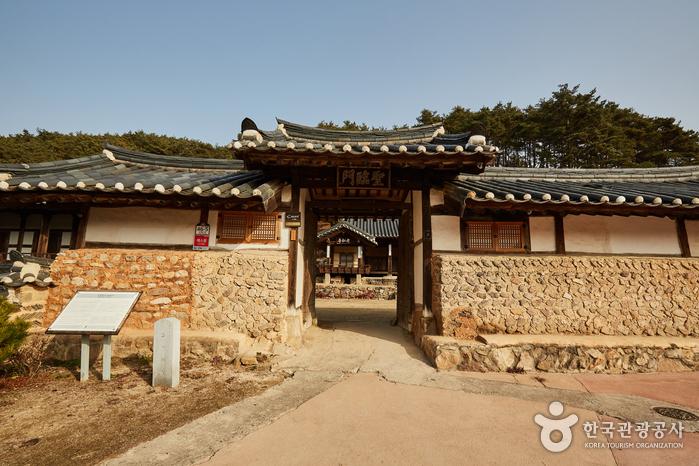Hanchaedang Korean traditional house [Korea Quality] / 한채당 체험한옥관 [한국관광 품질인증]
2020-09-09
695-9, Songui-ro, Sowon-myeon, Taean-gun, Chungcheongnam-do
+82-10-2629-0121
The Hanchaedang Hanok Stay Center consists of two hanok buildings with the same traditional structure, including a tiled-roof, maru (wooden floor), and gudeul (Korean floor heating system). The interiors offer a harmonious combination of modernity and the features of a traditional hanok house. Each room has a low table for four people, a central living room with en suite toilet and bidet, a main room (Anbang) with an en suite bathtub, toilet and bidet, another room (Geonneonbang), and a kitchen with a wine bar table. The main room has two sets of bedding for four people, while the other room has one set of bedding for two people. The extra bedding is always placed inside the wardrobe. Guests can cook in the kitchen, but they may only hold a BBQ outside. (There is a charge for the BBQ set.) The house overlooks the school playground below the building and the beach in the distance. The Hanchaedang is also a well-known film location with great interiors and attractive exterior views that have featured in various interview programs and TV dramas.
Seosan Hotel Aria [Korea Quality] / 서산아리아호텔 [한국관광 품질인증]
2020-12-16
94, Dongheon-ro, Seosan-si, Chungcheongnam-do
+82-10-3722-9898
Located near Jungang Lake Park in Seosan City, Chungcheongnam-do Province, the Seosan Aria Hotel has 80 guestrooms with a capacity of about 160 people in total. It consists of the main building (seven-story), new building (six-story), annex building (four-story), and deluxe building (four-story), and has a large parking lot with one parking space per room. The hotel has three types of rooms, each designed with a different concept and structure: The Garden Rooms, situated on the top floor (8F) of the main building, consist of a room and a roof-top garden; the Studio Rooms (82㎡), with a maximum capacity of 4 people, are equipped with a home theater system; and the Duplex-type rooms. The Hotel is 1km from Seosan City Hall and a variety of department stores, and offers easy access to public transportation.
Doraemi House [Korea Quality] / 도래미하우스 [한국관광 품질인증]
2020-09-09
18-26, Dongnyeok-gil, Dado-myeon, Naju-si, Jeollanam-do
+82-10-8616-6725
Doraemi House is a hanok stay type of tourist accommodation located in the village of Dorae, Naju City, Jeollanam-do Province. The house was named Doraemi, meaning “the beauty (mi) of Dorae”, in the hope of conveying the beauty of the village. The accommodation consists of three hanok structures - the Bonchae, Sarangchae, and Byeolchae. The Bonchae consists of two bedrooms with a garret; the Sarangchae has 2 bedrooms flanked by a living room; and the Byeolchae, located on a hill, is a cozy single room, with a wooden swing placed in front of the building. Doraemi House is decorated with cozy, natural items that create a relaxing atmosphere. A pleasant forest trail passes by the house and leads to Gyeeunjeong Pavilion, one of the village’s three pavilions, and a small pond. The owner of the house has established a small reading space filled with picture books next to the Bonchae building, where guests can enjoy reading amid a tranquil atmosphere.
Peepul Hanokstay [Korea Quality] / 연경당 [한국관광 품질인증]
2023-04-13
13-40, Jungheung-ro, Bonggang-myeon, Gwangyang-si, Jeollanam-do
+82-10-4665-9301
Opened in 2008, Yeongyeongdang, meaning ‘a house with fine sunshine’, is a hanok stay facility located about 6km from Gwangyang-eup in Jeollanam-do. It is set amid the beautiful scenery of Baegun Reservoir, Baegunsan Mountain, and Bibongsan Mountain, of which the family room commands a particularly good view. Yeongyeongdang has 5 guestrooms in total, each of which is equipped with an individual bathroom with bathtub and a toilet. The heating system consists of traditional Korean floor heating (gudeul), a boiler, an air-conditioner, and glass doors and windows to keep out cold draughts. Cooking is not permitted inside the rooms, but guests can use the large communal cooking room, which also provides snacks and has a beverage vending machine. Guests can also enjoy a BBQ or a meal in the courtyard where a wooden table is placed for that purpose. As there are no shops around the house, guests should bring food and other necessities with them. The rooms will be heated in advance if guests inform the owner of their expected arrival time.
Urban place gangnam
2021-04-09
30, Hyoryeong-ro 77-gil, Seocho-gu, Seoul
+82-02-3474-9108
Urban Place Gangnam located near Gangnam Station, Seoul is a 20-story building with 257 guestrooms. Parking is available on the basement up to the sixth floor. There are easy means of public transportation in the vicinity of the hotel including Gangnam Station on Seoul Subway Line 2, which is a mere 2-minute walk from the hotel. All the guestrooms are furnished with a kitchen, making it a great choice for business travelers and family tourists alike. There is a coin laundry on the 1st floor. The lobby on the first floor is very comfortable with various newspapers, magazines, and books, with a bakery & cafe right next to the lobby. The fitness gym is on the 9th floor, where you can enjoy a view of the city while working out. The hotel also has a conference room for business travelers who need to meet with their clients. Since it is located in Gangnam, the hub of public transportation, it’s very easy to get to many of the popular tourist destinations in Seoul.
Sieunjae [Korea Quality] / 시은재 [한국관광 품질인증]
2021-04-01
439, Samil-daero, Jongno-gu, Seoul
+82-10-5355-3029
Located in Gyeongun-dong, Jongno-gu at the very heart of Seoul, Sieunjae is a hanok with a longstanding tradition. It has three guestrooms including the anbang (main room), byeolchae (detached building), and jakeunbang (small room). The anbang is the only room with a living room, where various items of old furniture, including a comfortable sofa, create an antique atmosphere. The communal bathroom and toilets are supplied with toiletries, while the communal kitchen is equipped with cooking equipment and a washing machine.
The house can be rented either as individual accommodations or in its entirety. As it is situated in Jongno-gu, at the very heart of Seoul, guests can easily reach many nearby major tourist attractions. Car users are advised to use the public parking lot as the house has no parking spaces. Entering by a small gate, the little flowerbed comes into sight. This old hanok shows traces of repair works on the tiled roof.
Le IDEA Hotel Busan Station [Korea Quality] / 르이데아호텔 [한국관광 품질인증]
2023-04-13
16-10, Jungang-daero 180beon-gil, Dong-gu, Busan
051-441-0708
Le IDE:A Hotel is a boutique hotel opened in 2017. Located near Busan Station, Dong-gu, Busan, it has large rooms with area of over 33㎡ and comes with a large bed and a whirlpool bathtub. The 9-story building houses a total of 55 rooms that can accommodate up to 160 people in all. The rooms on the fifth floor offer a great view of Busan Harbor Bridge and the ocean. Some of the rooms are furnished with personal safe and closet for long-term guests. The Business Rooms with area of 16㎡ look like a studio room with some office supplies. The Group Rooms can accommodate up to 17 people, and they are available in both Korean ondol (floor-heated) rooms and those with a bed. The hotel is conveniently located near Busan Station and other means of public transportation such as metro bus, making it easy to get to other parts of the city. Nearby tourist destinations include Gukje Market, Jagalchi Market, Yongdusan Park, Taejongdae, and Downtown Busan.
Old GuAm-seo-won
2021-04-09
492-58, Gukchaebosang-ro, Jung-gu, Daegu
+82-53-428-9980
Old Guam Seowon is a traditional Korean guesthouse located between Dongseong-ro and Seomun Market in Daegu. With land area of 2,300㎡, it has a total of six guestrooms, a shared living room, a bathroom, and a kitchen. The house has a large yard where guests can play various traditional Korean games such as "tuho" and "jaegichagi." In the backyard, guests can shoot arrows and try on traditional Korean clothes. Both the guestrooms and bathrooms were remodeled to have some of the modern conveniences. If you want, you can cook at the shared kitchen. Bread and cup noodles are served for breakfast. Situated in a residential area downtown, it's both quiet and very conveniently located for those planning to tour the city. Nearby popular tourist destinations include E-World, Daegu Nature Park & Spa Valley, Seomun Market, Gukchaebosang Memorial Park, and Kim Gwangseok-gil Street, with easy public transportation to and from the downtown area.
Nosongjung Head House
2021-04-09
46-5, Onhyejungma-gil, Dosan-myeon, Andong-si, Gyeongsangbuk-do
+82-10-2065-3749
Nosongjeong, also called the “Placenta Chamber of Yi Hwang” (pen-name: Toegye, 1501-1570), is named after the pen-name ‘Nosong’ of Yi Hwang’s grandfather Yi Gye-yang. It is said that Yi Gye-yang abandoned his government position after he fell victim to the Gyeyujeongnan Suppression (a coup d’état instigated by Suyang Prince, who became King Sejo of Joseon, in 1455) and returned to his hometown in Bonghwa, where he devoted himself to teaching students. He built the house in its current location by a coincidence of saving a monk. The Placenta Chamber of Yi Hwang, which is situated deep in the house, consists of an Ondol (Korean floor heating) Room and a small numaru (upper floor) with a unique design. The gate bears a signboard with the word ‘Seonglimmun’ written by Hakbong Kim Seong-il (a direct disciple of Yi Hwang), which derives from the fact that the mother of Yi Hwang, Chuncheon Park, had a conception dream about Confucius entering the main gate with his disciples. Nosongjeong has an Ondol room in the west, with a numaru and a maru (wooden floor) in the east, which could accommodate 20 to 30 students. The signboard of Noseongjeong is believed to have been written by Han Seok-bong (a leading calligrapher of the mid-Joseon period). The structure of Nosongjeong is considered an invaluable resource for studies on the principles of building a half-hipped roof. The shrine is situated east of Nosongjeong, between which there was a juniper aged over 400 years from which the name of Nosongjeong was originated as people called the juniper as an old (no) pine (song). However, the original juniper has been replaced by its younger juniper tree with an umbrella shape of the top.
Traditional Resort Gurume [Korea Quality] / 구름에 [한국관광 품질인증]
2023-04-13
190, Minsokchon-gil, Andong-si, Gyeongsangbuk-do
+82-54-823-9001
Gurume Resort is where early traditional Korean guesthouses are located. The traditional Korean houses were relocated to this place after a flood. The resort consists of seven traditional Korean houses named "Baksanjeong,” "Cheongongjeong,” "Gamdongjaesa,” "Palhoedangjaesa,” "Gyenam Old House,” "Seounjeong,” and "Chilgok Old House." Built in the 17th century, "Baksanjeong" is the oldest house there, and it has one guestroom. “Cheongongjeong,” “Gamdongjaesa,” and “Palhoejaesa” were built in the 18th century, whereas "Seounjeong,” "Gyenam Old House,” and "Chilgok Old House" were built in the 19th century. For this reason, the traditional Korean houses look slightly different from each other with one thing in common: they were all renovated and equipped with comfortable modern facilities while preserving most of the features of a traditional Korean house. All the guestrooms are furnished with bathroom with shower and air conditioning system. A hi-tech security system is also installed to ensure the safety of the guests. In addition to Gurume Resort, Happy Traditional Village also has a book café housed in a traditional Korean house as well as dining restaurant, experience rooms, and plaza, allowing the visitors to lodge and engage in a wide range of activities. There is a special package for staying at an old traditional Korean house and using the auxiliary facilities. For more information on various events and news, please visit the Happy Traditional Village website.
![Seosan Hotel Aria [Korea Quality] / 서산아리아호텔 [한국관광 품질인증]](http://tong.visitkorea.or.kr/cms/resource/10/2580410_image2_1.jpg)
![Doraemi House [Korea Quality] / 도래미하우스 [한국관광 품질인증]](http://tong.visitkorea.or.kr/cms/resource/55/2575455_image2_1.jpg)
![Peepul Hanokstay [Korea Quality] / 연경당 [한국관광 품질인증]](http://tong.visitkorea.or.kr/cms/resource/40/1880740_image2_1.jpg)
![Sieunjae [Korea Quality] / 시은재 [한국관광 품질인증]](http://tong.visitkorea.or.kr/cms/resource/51/2447351_image2_1.jpg)


![Traditional Resort Gurume [Korea Quality] / 구름에 [한국관광 품질인증]](http://tong.visitkorea.or.kr/cms/resource/56/2581156_image2_1.jpg)
 Français
Français
 한국어
한국어 English
English 日本語
日本語 中文(简体)
中文(简体) Deutsch
Deutsch Español
Español Русский
Русский